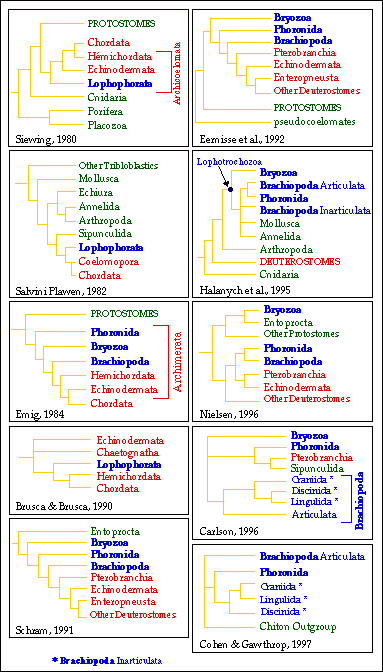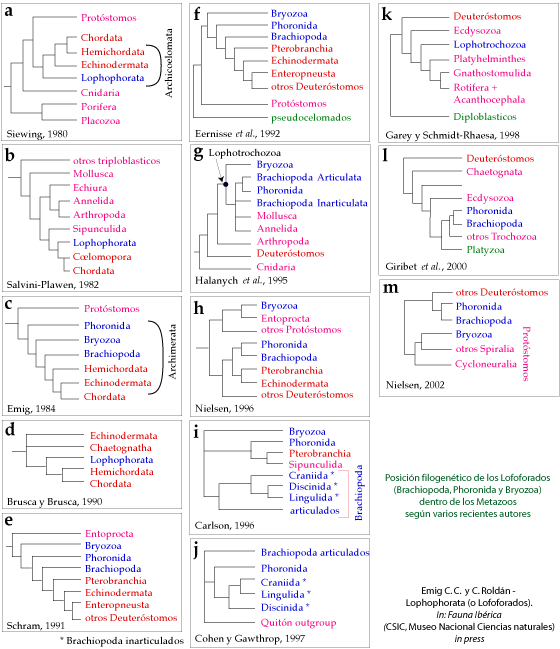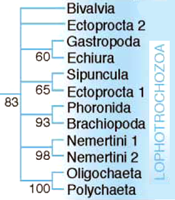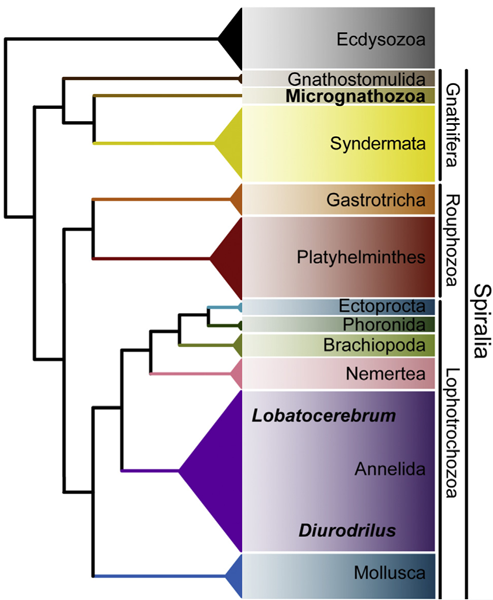|
Several authors regard Phoronida as constituting a separate phylum;
but others, including myself (Emig, 1977, 1997), consider them as a class within the phylum LOPHOPHORATA, which also includes the Bryozoa and Brachiopoda. These three groups share a ciliated lophophore.
The Phoronida is particularly distinguished from the other two lophophorate groups on the basis of its cylindrical body form living in a tube which can be compared to the shell of the Brachiopoda and to the exo-skeleton in the Bryozoa.
The phylogenetic relationships between Brachiopoda, Bryozoa and Phoronida and those of the LOPHOPHORATA among the Metazoa remain under debate (see Emig, 1997; Cohen & Weydmann, 2005) as shown on Fig. 1, Fig. 2 and Fig. 3: when based on molecular data these groups belong to the Protostomes, and when based on the traditional morpho-anatomical characters they appear as deuterostomes. These latter characters, particularly the blastopore, mesoderm, and coelom formation, have to be re analysed and their state tested on the basis of the Brachiopoda and Phoronida monophyly which has been established on morphological and molecular characters.
Nevertheless, Brachiopoda and Phoronida belong to a single phylum, the Lophophorata, while the state of the Bryozoa needs molecular confirmation.
|
Phylogenetic affinities of the Lophophorates: FIGURE 1 |
in: Emig C. C., 1997. Les Lophophorates constituent-ils un embranchement?
Bull. Soc. zool. Fr., 122 (3), 279-288.

© "Bulletin de la Société zoologique de France" - 195, Rue St-Jacques - 75005 Paris
and Christian C. Emig
|
Phylogenetic affinities of the Lophophorates: FIGURE 2 |
Emig C. C. & C. Roldán, 2005. Lophophorata (o Lofoforados). Fauna Ibérica (CSIC, Museo Nacional Ciencias naturales).

Nota: In various genetic databases, the occurrence of erroneous identifications of specimens, i.e., synonymous species, non-valid species, leads to misinterpretation of the results. Among the reasons: the purchase of the specimens in commercial companies which indicate unverified identifications - see Databases and Emig et al. (2015).
| Phylogenetic affinities of the Lophophorates: FIGURE 3 |
Glenner et al.,2004 |
Phylum Brachiopoda Duméril, 1806
- Subphylum Linguliformea Williams et al., 1996
- Class Craniata Williams et al., 1996
- Class Phoronata cl. nov.
- Class Lingulata Gorjansky & Popov, 1985
- Subphylum Rhynchonelliformea Williams et al., 1996
- Class Rhynchonellata Williams et al., 1996
Cohen & Weydmann, 2005 |
|
|
Laumer et al., 2015 |
|
|



 < enlarge
< enlarge